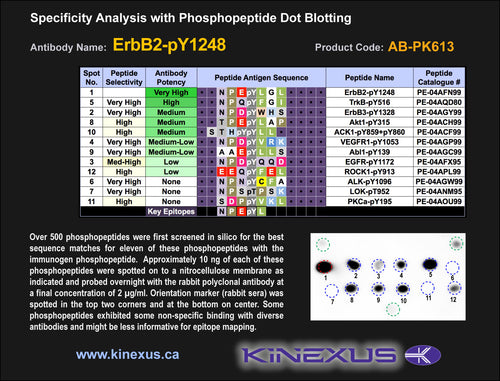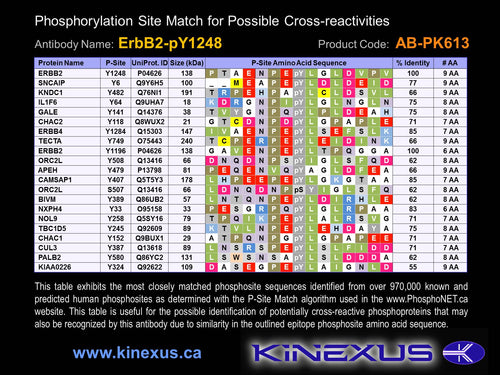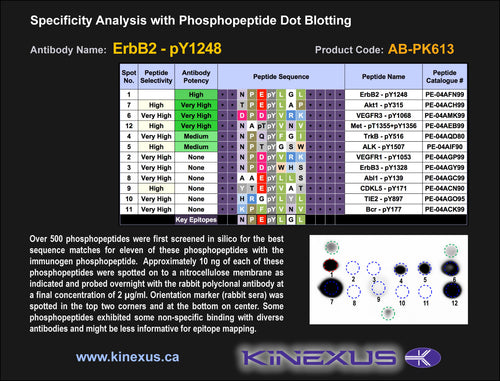Product Name:
ErbB2-pY1248
Product Number:
ab-pk613
Target Full Name: ErbB2 (Neu) receptor-tyrosine kinase
Target Alias: CD340; C-erbB-2; Epidermal growth factor receptor-related protein; ErbB2; HER2; HER-2; Kinase ErbB2; MLN 19; V-erb-b2 erythroblastic leukemia viral oncogene homolog 2, neuro/glioblastoma derived oncogene homolog (avian); TKR1; hCG_28177; ENSG00000141736; Q9NP09; Q9UK79
Product Type Specific: Protein kinase phosphosite-specific antibody
Antibody Code: PK613
Antibody Target Type: Phosphosite-specific
Antibody Phosphosite: Y1248
Protein UniProt: P04626
Protein SigNET: P04626
Antibody Type: Polyclonal
Antibody Host Species: Rabbit
Antibody Immunogen Source: Human ErbB2 (HER2, Neu) sequence peptide Cat. No.: PE-04AFN99
Antibody Immunogen Sequence: NPE(pY)LGL(bA)C
Antibody Immunogen Description: Corresponds to amino acid residues N1245 to L1251; In the C-terminus of the kinase after the catalytic domain
Production Method: Corresponds to amino acid residues N1245 to L1251; In the C-terminus of the kinase after the catalytic domain
Antibody Modification: Protein kinase phosphosite-specific antibody
Antibody Concentration: 1 mg/ml
Storage Buffer: Phosphate buffered saline pH 7.4, 0.05% Thimerasol
Storage Conditions: For long term storage, keep frozen at -40°C or lower. Stock solution can be kept at +4°C for more than 3 months. Avoid repeated freeze-thaw cycles.
Product Use: Western blotting | Antibody microarray
Antibody Dilution Recommended: 2 µg/ml for immunoblotting
Antibody Potency: Medium immunoreactivity of a target-sized protein by Western blotting in A431 and MCF7 cells. Medium immunoreactivity with immunogen peptide on dot blots.
Antibody Species Reactivity: Human
Antibody Positive Control: The observed molecular mass of the processed target protein on SDS-PAGE gels is reported to be around 138, 175-200 kDa.
Antibody Specificity: High-very high
Antibody Cross Reactivity: In HEK-293 cells, phenylarsine oxide (PAO) reduces 50 + 30 kDa proteins detection. In HeLa cells, phenylarsine oxide (PAO) increases 27 kDa protein immunoreactivity. In Jurkat cells, phenylarsine oxide (PAO) increases 15 kDa protein detection. In seastar oocytes, cross-reactivities are detected with phospho-ERK1 and phospho-CDK1.
Related Product 1: ErbB2-pY1248 blocking peptide
Related Product 2: ErbB2 pan-specific antibody (Cat. No.: AB-NK054-3)
Related Product 3: ErbB2 pan-specific antibody (Cat. No.: AB-NK054-4P)
Related Product 4: ErbB2-1 pan-specific antibody (Cat. No.: AB-NK054-4)
Related Product 5: ErbB2-2 pan-specific antibody (Cat. No.: AB-NK054-5)
Related Product 6: ErbB2-3 pan-specific antibody (Cat. No.: AB-NK054-6)
Related Product 7: ErbB2-4 pan-specific antibody (Cat. No.: AB-NK054-7)
Related Product 8: ErbB2-pY735 phosphosite-specific antibody (Cat. No.: AB-PK614)
Related Product 9: ErbB2-pY877 phosphosite-specific antibody (Cat. No.: AB-PK615)
Related Product 10: ErbBSubtide - ErbB2 protein kinase substrate peptide
Scientific Background: ErbB2 (HER2, Neu) is a protein-tyrosine kinase of the TK group and EGFR family. It is a kinase that function as a component of several membrane protein receptor complexes on the cell surface. Specifically, the ErbB2 protein functions in the regulation of the growth and stabilization of peripheral microtubules, as well as in the transcriptional activation of several rRNA genes (mediated by RNA polymerase I) that result in enhanced protein synthesis and subsequent cell growth. It is highly expressed and widely distributed in most tested human tissues except in the brain and spinal cord, where it is more moderately expressed. Protein interaction is induced with phosphorylation of Y1139 (with Grb2, Grb7 & Src), Y1196 (with Crk), and Y1222 (with CGI-27, Grb2 & Shc1). Phosphorylation of Y1112 induces interaction with Cbl, which promotes ErbB2 degradation. Overexpression of unaltered ErbB2 coding sequences in NIH-3T3 cells results in cellular transformation and tumorigenesis. ErbB2 is amplified in about 30% of primary human breast malignancies and overexpression of ErbB2 is associated with the most aggressive tumours that show uncontrolled proliferation, resistance to apoptosis and increased motility. ErbB2 has also been linked with the development of ovarian cancer, gastric and lung adenocarcinomas, and glioblastomas. Insertional mutagenesis studies in mice also support a role for this protein kinase in mouse cancer oncogenesis.




